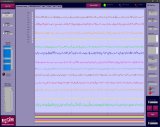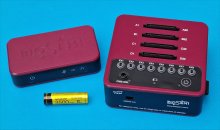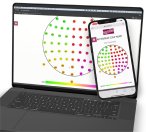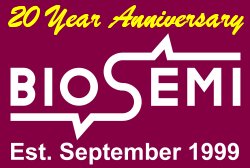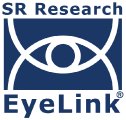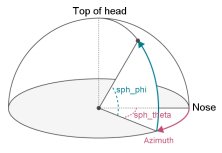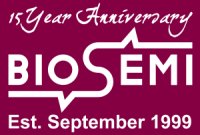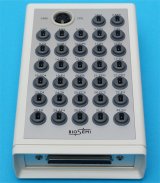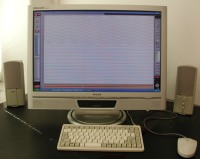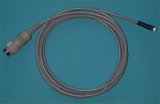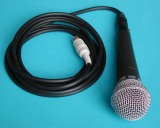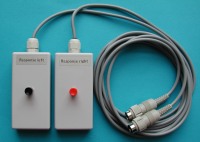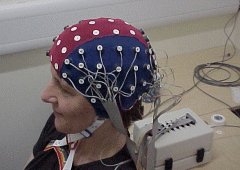|
| 21 November 2025 |
 |
|
|
| ActiView 10.4 is a major upgrade of the acquisition software for ActiveThree systems. A lot of code has been changed to make the software compatible with higher sample rates than the 16 kHz that is used for current ActiveThree AD-boxes (AD-boxes with a sample rate up to 262 kHz are under development). More relevant for current users is the repair of a bug that could lead to the generation of multiple LSL streams (sometimes, and on some computers). Connecting to one of multiple streams would crash ActiView. Even when the LSL connection was not used, the bug could cause unnecessary high use of processor power and network resources, resulting in slowed-down performance. Therefore, it is paramount for all ActiveThree users to upgrade to this new 10.4 version as soon as possible. For all changes, please refer to the "What's new" file. |
| Downloadable at the download page. |
| |
|
|
|
| 22 July 2025 |
 |
|
|
New ActiView 10.3 and AD-box firmware version 2.2 available for Active3 systems.
The combination of this new acquisition software and firmware enables two new features for all ActiveThree systems:
1) Support for Lab Streaming Layer
ActiView 10.3 has native LSL (labstreaminglayer.org) support. No extra plug-ins or further software is required and all regular ActiView functions (display, saving to BDF file, etc.) remain operational during LSL streaming. All installed EEG channels as well as the connected sensor channels are streamed to LSL, with the sample rate selected in ActiView. The preprocessing for the auxiliary sensors is performed in ActiView. The LSL streaming is handled by a separate software thread to prevent delay and jitter by the main display/saving-to-file thread. In addition, the instantaneous backlog value is transmitted for each streamed data package to allow LSL to compensate for computer processing delays (the backlog is the time between the moment that a sample is stored in the intermediate ringbuffer by the USB driver and the moment that it is read from the ringbuffer by the LSL streaming thread in ActiView). Latency and jitter values below 10 millisecond can be achieved this way.
The LSL support greatly simplifies the synchronized acquisition of ActiveThree combined with other measurement devices in the laboratory. Finally, LSL provides an alternative for developers of real-time applications for the ActiveThree system who do not want to explore the open-source ActiView code written in LabVIEW.
2) Selectable 4x or 8x ADC oversampling
Although the output sample rate of the ActiveThree system is fixed at 16 kHz, the ADCs internally operate at a higher sample rate. This allows the use of the steep anti-alias low-pass filter in the ADC (-3 dB at 5.4 kHz, > 65 dB at the Nyquist frequency of 8 kHz). Until now the oversampling rate has been set at 4x. With the new version 2.2 firmware, the oversampling rate can be selected between 4x (64 kHz internal sampling) or 8x (128 kHz internal sampling). The 8x oversampling rate provides an even better rejection of interference between 10 kHz and 100 kHz. Such interference may be generated by devices like switched mode power supplies in mains adapters, LED lighting and electric motors. Although these frequencies are well above the 5.4 kHz low-pass cutoff of the amplifier, they may still alias to interference in the EEG bandwidth; an effect that is more effectively prevented with higher oversampling. The higher oversampling rate increases power consumption with approx. 20%. However, this is mostly mitigated by the larger capacity Li-ion 18650 batteries that recently became available (4000 mAh, up from 3500 mAh).
As of now, BioSemi will ship all ActiveThree systems with the oversampling rate set to 8x. However, the new firmware still allows the system to switch back to 4x oversampling with a DIP-switch setting on the AD-box motherboard. This can even be done on the fly to easily evaluate the effect in a particular measurement situation (the selected oversampling rate is indicated in the new ActiView 10.3 in real-time). However, note that the AD-box needs to be opened to operate the DIP-switch, so testing whether the oversampling rate makes a difference in a particular situation remains a task for a specialist.
All previously delivered ActiveThree systems can in principle be updated to the new firmware to enable the 8x oversampling rate mode (no hardware changes are involved). In the vast majority of measurement situations, there won't be any difference and leaving the system on 4x oversampling will be fine. However, in case of particular interference problems due to a few narrow frequency bands between 10 kHz and 100 kHz, an upgrade to the new firmware might offer increased rejection. In these cases, contact BioSemi or one of it's local representatives to perform the update free of charge. |
|
|
| 14 December 2024 |
 |
|
|
25 Years BioSemi 40% Trade-in discount:
To celebrate the successful introduction of the Active3 system in the 25th year of existence of BioSemi, we offer a trade-in (swap) for all existing ActiveTwo systems (some of which are as old as 25 years by now and still operational)
The trade-in exists of the following offer:
With the trade-in, you would return your old Active2 system to BioSemi in return for a new Active3 system. Because older ActiveTwo electrode sets may not be compatible with the Active3, you also might need to buy new electrode sets (please check here)
Active2 auxiliary sensors are never compatible with Active3 and must be renewed. All headcaps remain compatible with Active3.
This trade-in offer is for existing ActiveTwo customers: after the return of an ActiveTwo system we will give 40% discount on the purchase of a new Active3 Base system including the same amount of modules as the traded-in ActiveTwo system (but not on extra channels, electrode sets, headcaps and auxiliary sensors).
So before planning any upgrade of an existing ActiveTwo system, consider the above trade-in.
All information about upgrading your ActiveTwo system. |
|
|
| 09 Aug 2024 |
 |
Hyperscanning Trigger Interface |
|
| The Hyperscanning BioSemi USB Trigger Interface gives Hyperscanning possibilities to any Active3 system. (in addition to all the normal functionality of the standard BioSemi USB Trigger Interface) |
| |
- Triggered Hyperscanning works up to 16 kHz.
- Triggered Hyperscanning offers an unlimited number of AD-boxes in the chain.
- Triggered Hyperscanning works over various platforms/devices. |
| |
| Hyperscanning is defined as: "recording brain activity from multiple individuals simultaneously" |
|
|
| 31 May 2024 |
 |
ActiveThree system in full production |
|
Active3 is the next generation of biopotential measurement systems for scientific research. The Active3 its cutting-edge SAR analog-to-digital converter technology offers perfect noise spectrum with total absence of spurious tones. BioSemi's third-generation active electrodes and amplifier system - the ActiveThree - combines extremely high signal quality, portability, low power consumption, and ease of use.
The Active3 can be configured with up to 142 channels of EEG/EXG electrodes and sensors. All 142 channels are fully DC-coupled and equipped with a novel 24-bit SAR (successive approximation register) A/D converter. This is the latest ADC technology available on the market, allowing for the highest signal quality with high interference suppression, offering a clean frequency spectrum. New low-voltage components further allow for lower power consumption compared to its predecessors. As a result, a much smaller-sized battery is used, leading to a decrease in both the size and weight of the main AD-box. Additionally, the battery can be purchased anywhere locally, as it is a standard single battery cell. Auxiliary sensors such as respiration belts, GSR/EDA sensors, and response switches are now automatically detected and configured by the system. Last but not least, the CMS/DRL circuitry has improved in interference suppression. |
|
|
| 10 October 2022 |
 |
Increased shipping costs |
|
The increased international shipping tariffs have forced BioSemi to let go of the free shipping for orders above 5000 Euro.
From today, BioSemi will always charge shipping costs, based on the shipment destination and on the weight of the package. |
|
|
| 30 August 2022 |
 |
ActiTools 9.02 released |
|
|
ActiTools has the following features:
- Trigger: Shows how to convert between binary to decimal trigger codes.
- Muter: Make a new BDF file with selected Trigger lines kept Low from an existing BDF file. (new in version 9.02)
-
Cropper: Crops large BDF files into smaller files.
- Merger: Merges 2 .bdf files into 1 .bdf file.
- Decimator: Decimates (downsample) your BDF file into a smaller file.
- Reducer: Reduces the number of channels in a BDF file.
-
Converter: Converts 24 bit BDF files to 16 bit AC (high-passed) EDF file.
- Repairer: Make a new BDF file from an existing BDF file with a corrupted file header.
- Editor: Edit the ID fields and channel labels in an existing BDF file.
- Configurator: Edit items which are not editable from ActiView in an existing configuration (*.cfg) file. (new in version 9.02)
- Equalizer: Make new BDF file with equalized ABR channels from an existing BDF file. (lower high-pass point) (new in version 9.02) |
| |
| Downloadable at the download page. |
|
|
| 27 March 2022 |
 |
ActiRead 9.02 released |
| 21 March 2022 |
 |
ActiView 9.02 released |
|
| ActiView 9.02 has the following new features: |
 |
Compiled for LabView 2021. |
 |
Identical versions for Windows, Mac and Linux. |
 |
In the monopolar display it is now possible to select the Left and Right ABR as the REF. |
 |
In the .cfg file you can now select if you want normal EEG channel ordering, or channel ordering for sEMG. |
 |
For all AD-boxes with ABR and up to 128 channels, it is now possible to also have a GSR input. |
 |
Ergo signals can be used to generate one-shot triggers on lines 9 and 10. |
| |
For explanation and application info, refer to this YouTube video: Neurospec Introduction to ABR |
| |
|
| |
Downloadable at the download page. |
|
|
|
| 16 December 2021 |
 |
ActiTools 9.01 released |
|
ActiTools has the following features:
- Trigger: Shows how to convert between binary to decimal trigger codes.
-
Cropper: Crops large BDF files into smaller files.
- Merger: Merges 2 .bdf files into 1 .bdf file.
- Decimator: Decimates (downsample) your BDF file into a smaller file.
- Reducer: Reduces the number of channels in a BDF file.
-
Converter: Converts 24 bit BDF files to 16 bit AC (high-passed) EDF file.
- Repairer: Make a new BDF file from an existing BDF file with a corrupted file header.
- New in version 9.01: editor for BDF headers.
|
| |
| Downloadable at the download page. |
|
|
| 24 June 2021 |
 |
View your Offsets in Real-Time on any Online Device |
|
Headcap Maps to show the offsets on the actual cap location were introduced in ActiView 8.11. However, a drawback that remained in practice was that the acquisition computer is often (and preferable) not located close to the subject. The headcap map would ideally be shown on wireless device that can be hold adjacent to the subject's head, thus allowing immediate indication and correcting of electrodes with bad skin contact. This scenario is now offered in ActiView 8.12 (or higher), in combination with the CapMap App running in any browser (Safari, Chrome, Firefox, Edge, etc) on any mobile device (smart phone, tablet, laptop, etc.)
| - |
Turn on the ActiveTwo system and run ActiView 812 or higher on a computer connected to the internet. |
| - |
In ActiView, go to the Offset tab-page and click the button "Upload to Cloud", with running acquisition, the offset values are now uploaded once a second to a secure internet server. |
| - |
Go to the About Tab-page and copy the server ID. |
| - |
Open a browser on your preferred mobile device, and go to: https://offset.biosemi.com |
| - |
Enter the server ID obtained in ActiView (App will remember the ID) - The offsets will be displayed with a refresh rate of 1-2 seconds. The CapMap App can connect to various ActiveTwo systems by changing the server ID. Multiple clients running the CapMap app can display the offsets simultaneous from the same ActiveTwo system. |
ActiView is an open source development by BioSemi BV (https://www.biosemi.com/download/LatestActiView/ActiView812/ActiView812.zip)
CapMap App is an open-source development by NEUROSPEC AG (https://neurospec.com/News#ns-news-2109)
Update 16 August: Movie about CapMaps: (https://www.youtube.com/watch?v=C6nFmsFgbO4) |
|
|
| 24 April 2021 |
 |
ActiView 8.12 released |
|
 ABR acquisition integrated in ActiView. (ActiABR no longer needed). ABR acquisition integrated in ActiView. (ActiABR no longer needed).
 Simultaneous ABR and EEG with HighSpeed firmware (speedmode 3, 16kHz), 128 channels EEG and 2 channels ABR. Simultaneous ABR and EEG with HighSpeed firmware (speedmode 3, 16kHz), 128 channels EEG and 2 channels ABR.
 Offset maps stored in the cloud. Offset maps can be displayed realtime with the MapsClient software on computers/tablets connected to the internet. Offset maps stored in the cloud. Offset maps can be displayed realtime with the MapsClient software on computers/tablets connected to the internet. |
| |
| Downloadable at the download page. |
|
|
| 09 April 2021 |
 |
BDFReader 8.13 released |
|
With BDFReader you can read .bdf files. The new version 8.13 has the following new features:
- Extra tab-page with zoom function and time and amplitude measurement.
- High-pass filter
For an example how to use these new features see this YouTube video about: Triggers -Presentation - Photocell |
| |
| BDFReader is downloadable at the download page. |
|
|
| 11 February 2021 |
 |
New FAQ added: How to compare BioSemi specifications with the specifications of other systems? |
| 08January 2021 |
 |
New product: Ergo Optical released |
|
| The Optical Ergo allows to connect analog signal sources to the Ergo input which need to remain isolated from the AD-box. For example connecting the audio output of a PC to the AD-box. The signal is transmitted over a 5 meter optical fiber. |
| |
More information available on the accessory page. |
|
|
| 13 October 2020 |
 |
ActiView 8.09 released |
|
 Offset maps added. Offset maps added.
 Window size is now fully resizable. Window size is now fully resizable.
 Some small visual changes. Some small visual changes. |
| |
| Downloadable at the download page. |
|
|
| 09 October 2020 |
 |
First scientific paper about research based on the special HyperSpeed version of the ActiveTwo released. |
| 25 May 2020 |
 |
|
| 01 September 2019 |
 |
|
|
On September 1st. 1999, BioSemi started as a university spin-off, introducing the first commercially available electro physiology measurement system with active electrodes, battery powered front-end and fiber optic data transfer to the signal processing computer.
20 years later we are happy to see that these original design ideas have established themselves in the scientific community, leading to thousands of scientific publications.
To celebrate this success, we offer a full spare electrode set on every Base system ordered between September 1st. and the end of 2019.
20 Years BioSemi Discount:
-
1 free electrode set on a 32 channel ActiveTwo system
-
2 free electrode sets on a 64 channel ActiveTwo system
-
4 free electrode sets on a 128 channel ActiveTwo system
-
8 free electrode sets on a 256 channel ActiveTwo system |
|
|
| 29 March 2019 |
 |
|
|
| The SR Research Eyelink stimulation software is now standard compatible with BioSemi systems. |
| |
|
|
| 24 October 2018 |
 |
|
| 05 July 2016 |
 |
|
|
| All the BioSemi ActiveTwo EEG headcaps can very easily be made compatible with the new electrode positioning system called "Krios" from NDI. Customers can choose to put the reflective markers (8mm outer diameter, 4mm inner diameter) on the headcap holders or on the PIN electrodes themselves. Click here for a demo about the Krios. |
| |
The Krios system is optimized for easy hand held operation with an integrated touch probe.
Reduces the time and complexity of electrode registration and identification.
Captures marker positions to accuracy within 0.5mm RMS.
Provides .csv output format for easy import into specialized analysis software. |
| |
| The Krios system can be ordered directly from BioSemi. |
|
|
| 17 July 2015 |
 |
|
| 21 April 2015 |
 |
|
|
BioSemi has written this new example program in Matlab. This program is able to receive the data being sent over TCPIP by ActiView.
In ActiView, on the ActiView tab-page "TCP Server" you can configure ActiView to stream the acquisition data 'live' over the network.
This small example program is able to receive this data and display 1 channel.
Free for everybody to use. Available in the download section. |
|
|
| 23 December 2014 |
 |
|
|
OpenViBE is a free and open source software platform dedicated to designing, testing and using brain-computer interfaces. OpenViBE is software for real-time neuroscience (that is, for real-time processing of brain signals). It can be used to acquire, filter, process, classify and visualize brain signals in real time.
|
|
|
| 01 September 2014 |
 |
|
|
On September 1st. 1999, BioSemi started as a university spin-off introducing the first commercially electro physiology measurement system with active electrodes, battery powered front-end and fiber optic data transfer to the signal processing computer.
15 years later we are happy to see that these original design ideas have established themselves in the scientific community, leading to thousands of scientific publications.
To celebrate this success, we offer a 1000 Euro discount on the Base system price for every new system ordered between September 1st. and the end of 2014.
|
|
|
| 19 September 2013 |
 |
|
|
MK2 AD-boxes, USB receivers and ActiView can be upgraded at no costs to feature 4 extra 'High-Speed' Speedmodes:
Speedmode 10: 256+8 channels @ 4 kHz
Speedmode 11: 128+8 channels @ 8 kHz
Speedmode 12: 256+8 channels @ 8 kHz
Speedmode 13: 128+8 channels @ 16 kHz
The 'MK2HS' firmware involves upgrading the firmware inside the AD-box, firmware inside the USB receiver and using ActiView706 or higher.
After this upgrade, when selecting Speedmodes 0,1,2,3 on the AD-box, then ActiView will display Speedmodes 10,11,12,13.
With the 'Normal' firmware, Speedmode positions 0,1,2,3 are used for Daisy chaining. (Displayed in ActiView as 0,1,2,3)
With the 'High-Speed' firmware, Speedmode positions 0,1,2,3 are used for the above High-Speed Speedmodes. (Displayed in ActiView as 10,11,12,13)
With the MK2HS 'High-Speed' firmware: |
| - |
Daisy-chaining is not possible. (because the MK2HS firmware replaces the Daisy-chain Speedmodes 0,1,2,3 with the 'High-Speed' Speedmodes 10,11,12,13, Daisy chaining is not possible anymore when your AD-box and USB receiver have been programmed with the 'High-Speed' firmware) |
| - |
No AIB can be connected. |
| - |
Not compatible with other firmware, not compatible with other USB receivers, not compatible with other AD-boxes. (MK1 or MK2) |
| - |
No Jazz eyetracker possible, ABR mode is possible. |
|
|
|
| 05 September 2013 |
 |
VIDEO: Training the Older Brain in 3-D |
| 31 May 2013 |
 |
Electrode coordinates file now also includes Cartesian coordinates. |
|
| New Electrode coordinates file, including calculation to Cartesian. |
| - Available at the download page. |
| |
| |
| |
| |
| |
|
|
| 17 October 2011 |
 |
Headbox ACT32 added to website. |
|
Every Headbox gives the possibility to connect 32 Active TouchProof electrodes to a standard ActiveTwo acquisition system.
- Inputs: 32 x Touchproof connector, 1 x CMS/DRL DIN4 connector.
- Outputs: 1 x 68-pole fine pitch female connector.
- Including 68-pole male to 68-pole male flatcable. (1 meter) |
|
|
| 04 April 2011 |
 |
New publications added. |
| 19 March 2010 |
 |
BioSemi offers Multi-platform operation ! |
|
A new driver family for the USB receiver is now available at the Download page.
This new family of drivers offers 2 unique features: |
| 1) |
Versions are available for Windows, Mac and Linux. Since BioSemi acquisition software is written in open source, platform independent LabVIEW programming language, essentially, the same source code can be transferred between the 3 platforms. Consequently, BioSemi is the first manufacturer of electro physiological instrumentation who is able to offer a complete platform independent system. |
| 2) |
The 'Stride' parameter is now adjustable. The stride parameter controls the burst length used in the USB transfer. This burst length is a trade-off between making the system as 'real-time' as possible. (minimal burst length) and processor load. A burst length of 64 msec stride is a value that works on most computers, for 2GHz Pentium 4's and newer. Stride values of 32, 16, 8, 4, 2 and 1 msec were tested successfully on recent Core 2 Duo machines. The minimal stride value of 1msec will satisfy even the most critical Brain Computer Interface (BCI) applications. |
|
|
| 29 March 2007 |
 |
ActiView 6.03 and 4 x tool released |
| 01 February 2007 |
 |
New Accessory |
|
| |
Light detector for direct connection to the Ergo input.
The sensor consists of a sensitive PIN diode with integrated trans impedance amplifier. This sensor can be used for measuring visual stimuli simultaneously with the physiological data (EEG). This allows checking the timing accuracy of the used stimulus setup. |
| |
| More information available on the accessory page. |
|
|
| 01 February 2007 |
 |
New Accessory |
|
| |
Extra Aux connector with bi-polar analog input for isolated sensors.
Bi-polar analog input on the front of the AD-box for all kinds of general isolated auxiliary signals (e.g. custom made GSR measurement device, microphone, photo sensor). DIN 5-pole input connector on AD-box front-panel. Single 5 Volt power supply available (300 mA max)
- Including 2 ADC channels.
- Input range: +/- 1 Volt. |
| |
| More information available on the accessory page. |
|
|
| 26 January 2006 |
 |
Free GSR upgrade available. |
|
Following up on a forum discussion about various GSR measurements methods, we have developed an alternative for the 'high-frequency' GSR method that we have used so far. The GSR module can now be delivered with either 16 Hz or 512 Hz excitation current. (Automatic detection in ActiView). The 16 Hz version displays and saves in nanoSiemens, whereas the 512 Hz version displays and saves in Ohm as before.
Read everything about it on the forum. |
| |
| |
|
|
| 26 September 2005 |
 |
ActiView 5.34 'Multi box' released |
|
ActiView acquisition software is now capable of recording data simultaneously from a maximum of 4 'daisy chained' AD-boxes. This enables studies on up to 4 subjects with 128+8+sensors channels per subject. The total data output of 608 channels is interfaced by a single PC and stored into a single data file for further analysis. The daisy chain setup ensures that the data from the 4 subjects is fully synchronized. This unique feature (this technology is currently only offered by BioSemi), allows the exploration of a new field of research on multiple subjects. |
| |
| Download the latest ActiView on the ActiView page. |
|
|
| 15 April 2005 |
 |
New Accessories |
|
| |
| Microphone to record audio stimuli and responses. A highly effective built-in spherical filter minimizes wind and breath 'pop' noise. Connects directly to the standard BioSemi ActiveTwo Ergo input on the AD-box. |
| |
| More information available on the accessory page. |
|
|
| 08 April 2005 |
 |
ActiveTwo AD-box updated to 280 channels. |
 |
| The addition of 3 extra octal amplifier/converter modules brings the total number of channels of the ActiveTwo system to 280. (up from 256 on the previous version) |
| This allows the system to be configured for 256+8 electrodes and 7 additional sensors on 2 kHz. For example, you can now use the system with a 256 channel headcap + 8 FLAT electrodes + 7 sensors. In addition, the amount of available channels in higher sample rate modes (4,8 and 16 kHz) was also increased substantially. |
| The update opens even more opportunities in high density EEG and BSPM recordings. |
|
|
| 07 April 2005 |
 |
ActiView 5.30 released. |
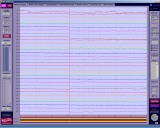 |
| The Following changes have been made: |
 |
New feature: Suitable for ActiveTwo Mk2 (280 channels), downwards compatible with ActiveTwo Mk1. |
 |
New feature: Continuous battery indication on all Mk2 AD-boxes. |
 |
New feature: line width and cursor type selectable in CFG |
 |
New feature: Ergo display low-pass filter can now be switched on and off. |
 |
New feature: TCP/IP server added. Data can be streamed real time on the network/internet. |
|
|
| 05 April 2005 |
 |
New Accessories |
|
| |
Response switches for direct connection to the AUX (front) connectors on the AD-box.
The setup with the response switches connected directly to the AD-box ensures accurate timing of the response moments (pulse is mixed directly with the incoming EEG signals) as well as optimal isolation of the subject (no grounded equipment near the subject). |
| |
| More information available on the accessory page. |
|
| |
|
|
| |
| The Presentation cable connects the stimulation PC (parallel port) with the trigger input/output connector (37 pin female sub-D) of the BioSemi USB receiver. |
| |
| More information available on the accessory page. |
|
|
|
|
| 21 March 2005 |
 |
New scientific papers added on the research page. |
 |
| 2 new papers by Peter Praamstra (university of Birmingham) added to our research site. During 4years of using ActiveOne and ActiveTwo systems, Peter Praamstra's research resulted in no less than 8 papers. If you want your paper about research involving BioSemi products added to our website, please do not forget to sent us the reference. |
|
|
|
| 08 February 2005 |
 |
New Accessory: Jazz Eyetracker. |
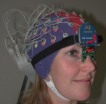 |
The Jazz eye tracker system is a development of a Polish academic research group, led by Prof. Ober.
A special 'synchronic' version has been made on OEM basis for BioSemi for interfacing directly with the ActiveTwo.
More info about the Jazz Eyetracker can be found on the accessory page. |
|
|
|
| 06 July 2004 |
 |
Electrode position coordinates file available for download. |
| |
Polar coordinates for all standard electrode caps (16, 32, 64, 128, 160, 256) are now downloadable in excel file format.
You can use these coordinates in your software to process BDF files. |
|
|
| 28 June 2004 |
 |
ActiView 5.21 released. |
 |
| The Following changes have been made: |
 |
Compiled in new version LabVIEW 7.1 |
 |
New feature: Decimate option enabled in all speedmode's (previously only available in mode 0 and 4) |
 |
New feature: Front panel connected response switches (connected to Aux/ERGO) can be routed to Trig 9 and 10 by a setting in the CFG file (RespSwitch = 0 or 1) |
 |
New feature: 1V, 2V and 4V options added to Y-scale selector on AIB tab page |
|
|
| 18 May 2004 |
 |
ActiView 5.19 released. |
 |
| The Following changes have been made: |
 |
New feature: Open ActiView+CFG file with a Windows shortcut. With this new feature, it is possible to make Windows shortcuts which automatically open ActiView with a specific CFG file. |
 |
Bug repaired: When only GSR1 was selected and a CFG file with this setting is saved and loaded again, then the 'Aux chart' was wrongly disabled. |
 |
Bug repaired: When the 'Aux chart' was disabled (by editing the CFG file manually), then with saving the sensors 'as displayed', the triggers were saved in channel 2 instead of in the trigger channel (last channel). Contact BioSemi for having your files repaired, if needed. |
 |
AIB offset graph scaling bug repaired. |
|
|
| 01 April 2004 |
| BioSemi discussion forum online. |
|
The new BioSemi discussion forum is now on-line at http://www.biosemi.nl/forum
We hope that the forum will quickly grow into a lively platform for discussions related to scientific research with BioSemi products. In the mean time, we would appreciate all your suggestions for improvements to the forum web site, please do not hesitate to email your comments. |
|
| 08 January 2004 |
 |
New dealer for Japan: Mackie 3M Specialties. |
| |
BioSemi is proud to announce our new dealer in Japan. |
| |
|
| 07 January 2004 |
 |
ActiView 5.14 released. |
 |
| The Following changes have been made: |
 |
During saving, the number of mono polar displayed channels could still be changed with the keyboard shortcuts (Page up/down). In 5.14, the Page up/down keyboard shortcuts have been disabled during saving. |
 |
To prevent the user from accidentally closing the acquisition during saving, the ActiView program window has been made "not closeable" as long as ActiView is acquiring data. This prevents corrupted header errors (-1, unknown length) and failures from closing the USB drivers not properly. |
 |
Keyboard shortcuts disabled when ActiView window is not active. |
 |
Keyboard shortcuts disabled when a numerical control is active. |
 |
Several LabVIEW code improvements: (Code in orange panel 2 simplified, Code cleaned up: error initialization constants were hidden behind outer while loop). |
 |
With the function keys F1-F8 it is now possible to set markers during acquisition.
The function keys F1-F8 have been "orred" with triggers 9-16, so the external triggers still work.
Function keys can thus be used to set markers in the file |
|
|
| 29 August 2003 |
 |
New dealer for Switzerland/Australia/New Zealand: NEUROSPEC AG |
| |
BioSemi is proud to announce this new dealer for EEG, EMG and ECG products. |
| |
|
|
| 27 August 2003 |
 |
NEW PRODUCT: USB2 receiver |
 |
As usual, BioSemi is the first in introducing innovative products.
BioSemi is the first company shipping it's systems with an USB2 interface. |
Plug&Play and easy driver installation. (no cards to install, just plug the USB2 cable in the PC)
The USB2 receiver makes higher data rates possible. (288 channels @ 4KHz samplerate 24bit/channel)
The new Receiver allows direct interface with notebooks. In combination with the compact, light-weight battery-powered ActiveTwo with Active Electrodes (eliminated the need for a Faraday Cage), this is the only real portable 256 channel EEG/ECG/EMG laboratory available. |
| |
| Also, as usual, BioSemi offers ActiveTwo customers attractive upgrade prices&possibilities. For 1400 Euro you can upgrade to USB2 and have all the advantages of doing acquisition on your notebook. |
|
|
| 22 August 2003 |
 |
ActiView 5.03 released. (for new USB2 interface) |
 |
ActiView versions 5 and higher are based on LabVIEW 7.0 and the new USB2 receiver.
The Following changes have been made: |
 |
Version only compatible with USB2 interface |
 |
In the .CFG file an extra setting has been introduced: "ElecGain".
When the system has been equipped with modules with a gain of 31,25nV/bit then set "ElecGain=0" (standard)
When the system has been equipped with modules with a gain of 125nV/bit then set "ElecGain=1" (BSM applications) |
 |
Warning "for research only" added |
 |
File limit bug corrected (program could run into 2GB Windows file limit before internal limit triggered proper closing of the file) |
 |
Window resized to dimensions available in Windows XP (smaller height than classic look) |
 |
Handling of arrays changed for more efficiency |
|
|
| 25 June 2003 |
 |
ActiView 4.03 released. |
 |
ActiView version 4 and higher are based on LabVIEW 7.0 and thus need the new LabVIEW
RunTimeEngine 7.0. ActiView is the acquisition program for the ActiveTwo system. It is an open source program written in LabVIEW 7.0 New features are: |
 |
Source code upgraded to LabVIEW 7.0 (RunTimeEngine 7.0 or higher is needed to run
ActiView versions of 4.0 or higher). |
 |
Free channel selections now work with SHFT and CTRL, according to the standard
Windows convention. |
 |
Reset of LP filters at every screen start removed, processor load by filters decreased. |
 |
Low pass filter added to online average. |
|
|
15 May 2003 |
 |
"Pin-type" product page updated. |
|
The BioSemi "Pin-type" Active electrode has been designed especially for mounting in BioSemi headcap's. The electrode has a sintered Ag-AgCl electrode tip, providing very low noise, low offset voltages and very stable DC performance. |
|
|
| 24 February 2003 |
 |
Auditory Brainstem Response measurement ABR. |
| ActiveTwo Application example: Auditory Brainstem Response (ABR) measurement. |
|
The high sample rate, high resolution and precise trigger timing makes the ActiveTwo very suitable for the demanding ABR measurement. Yet another example of the ActiveTwo's versatility.  Read more.... Read more.... |
| 04 December 2002 |
 |
"Ultra Flat" product page updated. |
|
The BioSemi UltraFlat Active electrode (11mm width, 17mm length, 4.5mm height) has been designed for all Body-surface applications. The flat shape makes the UltraFlat ideal for all EMG and ECG body surface measurements and also for EEG applications where the use of a headcap is less practical e.g.: sleep research. |
|
| 12 November 2002 |
 |
NEW PRODUCT: Analog Input Box. |
|
The Analog Input Box (AIB) is an extra option to acquire additional analog input signals which have to be kept isolated from the subject. For example mains powered equipment. Up to 32 channels can be acquired simultaneously with up to 256 channels from the AD-box connected to the subject. A first fiber carries the data coming from the subject connected AD-box to the AIB, then a second fiber with the combined data goes from the AIB to the receiver where the total 288 channels are processed. |
|
| 16 August 2002 |
 |
First full 256 channel ActiveTwo system installed. |
| |
The world's first 256 channel EEG system with active electrodes is now operational at the Biomedical Imaging Lab at the University of Houston. Director Prof. George Zouridakis has stimulated BioSemi to develop this technological breakthrough for his newly found laboratory. |
|
| 13 March 2002 |
 |
BioSemi introduces BDF (BioSemi Data Format)  |
| |
The BDF file format is the same as the EDF  file format except with 24 bit data records. file format except with 24 bit data records. |
|
| 27 September 2001 |
 |
Cortech Solutions added as new dealer. |
| |
We are proud to announce that Cortech Solutions will be representing the BioSemi EEG and sEMG product-line in the USA & Canada. |
|
|
| 13 September 2001 |
 |
BioSemi adds Megis to it's software alliance partners. |
| |
BioSemi is appointed as a dealer for the BESA package. The BioSemi hardware together with the BESA software forms a complete EEG analysis tool. A link to the BESA software can be found on the software page. |
|
|
| 2 July 2001 |
 |
BioSemi will show the latest systems on the NFSI 2001 in Innsbruck. |
| |
 |
The large number of channels offered by BioSemi systems is especially useful in EEG and ECG research where source localization plays an important role. There for BioSemi will show it's products at the NFSI2001 technical exhibition. We look forward to meet you at our booth at the technical exhibition. |
|
|
| 11 December 2000 |
 |
ActiveOne system successfully tested in MEG room. |
| |
New tests further proves the exceptional flexibility of the ActiveOne system. The first no compromise system which can be used for all applications inside and outside the MEG/MCG room. Read story. |
|
|
| 13 November 2000 |
 |
Testing finished on 2 wire version of Active Electrode for systems with 144 to 272 channels. |
| |
The current shipping versions of our Active electrode uses 3 connection wires. This prevented the use in headcap's with more than 144 channels, because this would result in too much bulk and weight of the large number of wires to the cap. BioSemi now presents a new version of the active electrode with only two wires. In this new design, the output signal and the negative powersupply use the same wire. All tests showed the performance of this ActiveTwo electrode to be identical with the successfully ActiveOne design. This breakthrough in Active electrode design opens the way to the practical realization of EEG systems with up to 272 channels, for which the PC interface under LabVIEW 6, has already been ready and tested for some months. |
|
|
| 12 May 2000 |
 LAUNCHING CUSTOMER STARTS USING ActiveOne system. LAUNCHING CUSTOMER STARTS USING ActiveOne system. |
During the past weeks, the first 144 channel ActiveOne system was installed in the Behavioral & Brain Science Centre, University of Birmingham, UK. The system uses up-to 128 pin-typed active electrodes for mounting in a cap. Simultaneously 8 flat-type active electrodes are used for EMG recordings. The 8 remaining channels are used for strain gages measurements. All this data (144 channels x 2048Hz sample-rate x 16 bit) is processed with BioSemi acquisition software running under LabVIEW (windows 2000).
Dr. Peter Praamstra from the Behavioral & Brain Science Centre, University of Birmingham UK, started using this system for his new research program. |
|
|
| An example of his first measurements can be downloaded here. |
| |
| The front-end behind the subject is a complete 144 channel acquisition system with battery-pack. All signals are pre-amplified on the electrode and digitized in the box and transferred to the PC through a single optical fiber. No separate headboxes or 19" racks as in competing systems. |
|
| 24 November 1999 |
| TESTS WITH ACTIVE ELECTRODES SUCCESSFUL. |
BioSemi has just just completed the tests of the first batch of series produced active electrodes.
The experience gathered with earlier designs now enables us to be the first company offering commercially available biopotential measurement systems with active electrodes. For reasons of subject safety and optimal performance, the active electrodes are not merely offered as a first-stage for conventional amplifiers. Instead, BioSemi has chosen to develop the active electrode as part of a fully integrated system consisting of electrodes, isolated AD-box, Powerbox and PC interface. This new ActiveOne system (versions from 16 up to 128 channels) will be available from approximately February 2000. Please feel free to email us for additional information. We are taking orders for the first series of EEG systems now, active multichannel surface EMG and BSM ECG systems will follow later in 2000.
To get an impression of the performance that can be achieved with the active electrode setup, you can download an EEG data-file with a player from our download site.
The electrodes were attached on the unprepared skin. The subject was sitting behind his computer, surrounded by electrical equipment. In this situation we were not able to record anything but hum and noise with conventional high-quality electrodes. |
|
 |
|














